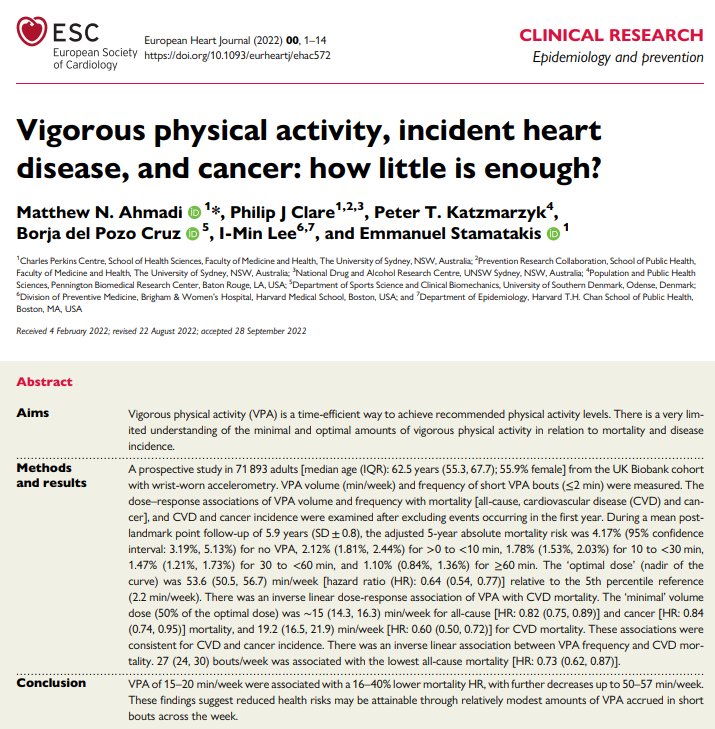Updated 2024!
This is an old story, but one with confusing data. The U.S. Department of Health and Human Services’ current physical activity guidelines recommend as little as 150 minutes of moderate physical activity [MPA aka simple “activity”] per week (to which it has recently added 75 minutes of vigorous physical activity [VPA aka exercise] or an equivalent combination of both. Given that almost anything counts as MPA ie “activity” eg going for a walk, doing housework…..150mins is not very much (it’s 21mins per day). VPA ie “exercise” includes jogging, cycling, swimming etc and that would be as little as 10mins per day. However around a third of the population do almost nothing at all, 60% do no vigorous exercise, and 80% do no strength training.
This is also an area with a large number of beliefs, which might well be myths; or at least uncertainties and these are:
Guideline rates of exercise are enough
Too much exercise is bad for you, so only do a little
Too much VPA is definitely bad for you, so only do a little
If you do MPA, then you don’t need any VPA
Fortunately a new study published in Circulation has examined all these, and the results are not as expected.
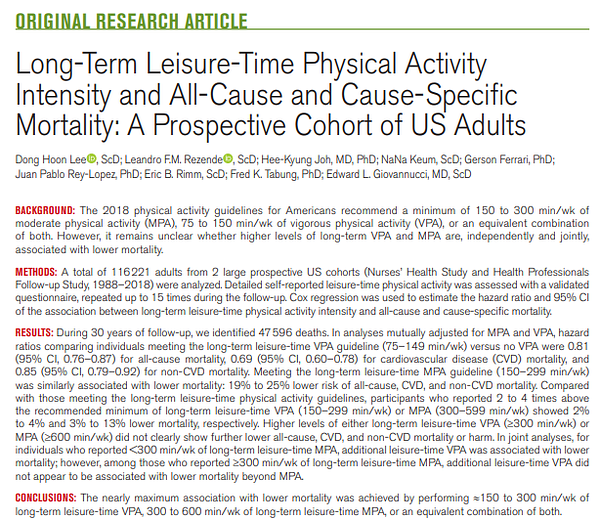
This study combined 2 large prospective US cohorts (Nurses’ Health Study and Health Professionals Follow-up Study, 1988–2018) in order to examine 116,221 adults using a self-reported questionnaire repeated up to 15 times beginning in 1986 and continuing for 30 years of follow up!
Myth 1: Guideline rates of exercise are enough
OK, Let us examine myth 1, that doing the recommended amount is enough.
During 2984545 person-years of follow-up (median, 26 years) there were 47596 deaths.
In terms of long-term leisure-time MPA, compared with those with no MPA, participants who met guidelines had 20% lower all-cause mortality and 22% lower CVD mortality
Compared with those with no VPA, participants who met the long-term VPA guidelines (75–149 min/wk of VPA) had 19% lower all-cause mortality and 31% lower CVD mortality
So far, so good, but if you did the optimal amount of MPA (500mins) you could lower your risk to 0.69 (ie 31% lower vs 20% above); and if you did the optimal amount of VPA ( 400mins) you could lower your risk to 0.73 (ie 27% lower vs 19% above)
Myth 2: Too much exercise is bad for you, so only do a little
The research also showed a dose-response relationship, the more MPA you did, the better. This is shown on the the following graph, at 600 mins MPA (thats 10hr per week or 1.4hrs / day) you get 32% risk reduction
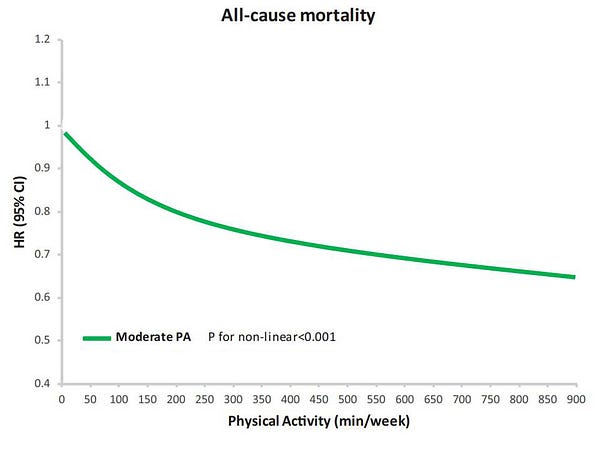
Now a thought experiment……given the line becomes almost linear after 500mins, what amount of time “active” would give 50% risk reduction??

Risk of Mortality vs Active time Per Day
32% risk reduction = 1.4 hrs per day
50% risk reduction = 2.6 hrs per day
75% risk reduction = 4.7hrs per day
99% risk reduction = 6.6 hrs per day!
Myth 3: Too much exercise (VPA) is definitely bad for you, so only do a little
This is interesting. The research also showed a dose-response relationship in terms of VPA / exercise, the more VPA you did, the better but there was a plateau, with not much benefit above 400mins VPA/week *but no evidence of harm either*
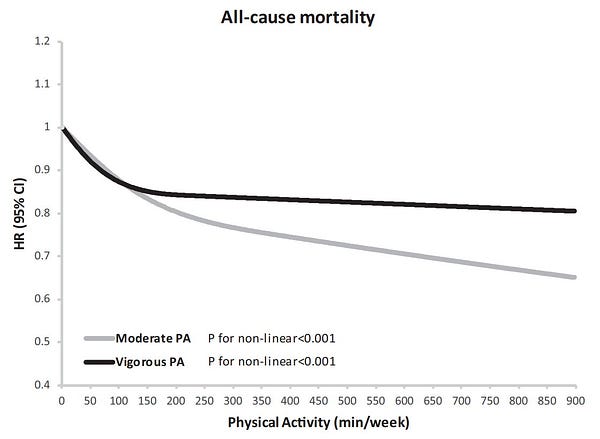
So, if you had a choice, and based on this data, I would say you should not limit your VPA for fears of “no benefit”.
Myth 4: If you do MPA, then you don’t need any VPA
The researchers also looked at the *combination* of activity vs exercise . Here are the results. Each block at the bottom is a band of activity (MPA) and each coloured dot is a band of exercise (VPA)
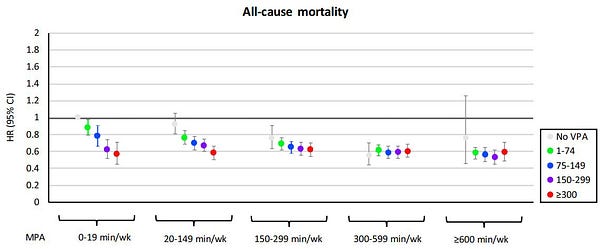
What this shows is; if you are inactive, you get a massive benefit of any duration of true exercise especially 150mins/week or more (that is only 21mins per day)
However if you were doing roughly an hour a day or “activity” then the benefits of exercise were not as clear BUT this was confounded by large uncertainty in those doing no VPA (likely due to sample size).
New: Optimal Percentage of Hard Activity
Oct22 saw a new study in Europ Heart J from Matthew Ahmadi
The contribution was 8% and for cancer mortality, there was no appreciable decrease beyond 15.0%
Bouts of intense exercise up to 2 min were optimal at 27 to 31 bouts/week
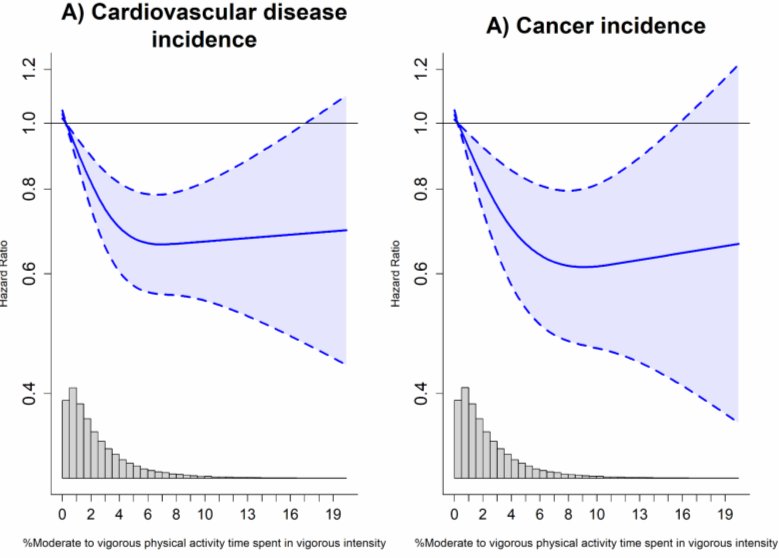
2023 López-Bueno et al JAMA
I found this new impressive nationwide prospective cohort study from the US National Health Interview Survey involving half a million US adults over 10.0 years (5.6 million person-years)
from 1997 to 2018. The first heads-up is the numbers in every category of exercise were published. 35% did almost nothing at all, 60% did no vigorous exercise, and only 22% did any strength training.
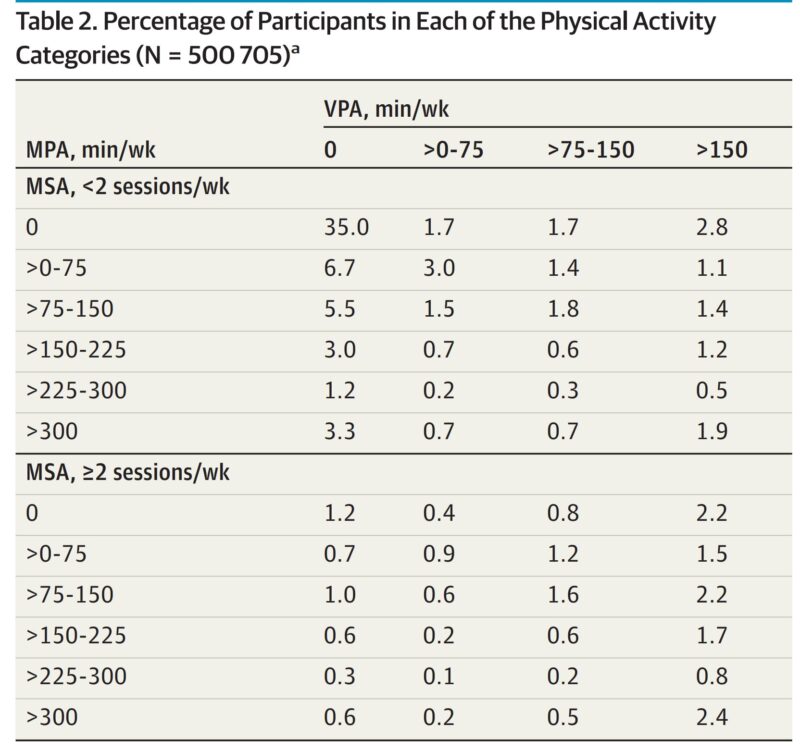
Next they helpfully published a gradient table ofr risk by exercise status. Adjusted all cause mortality was strong influence by both VPA and MPA and weakly by addition of additional strnegth training.

Effects were basically the same in sub-analysis of cardiovascular and cancer mortality except that MPA above 300mins/wk with some VPa and strength was optimal in preventing cancer mortality.
Conclusion: Are Guidelines Correct?
What this study (Lee et al) shows is that if you do the minimum qualifying activity and exercise US guidance 150 minutes MPA “activity” per week and 75 minutes of VPA aka exercise you get about 30% risk reduction.
BUT by adding more MPA or more VPA you could get 45% risk reduction.
The second study (Ahmadi) suggests around 8-15% of active time should be intense exercise (although the effect of even higher rates is likely to help more than harm)
Citation
https://pubmed.ncbi.nlm.nih.gov/37548973/
https://www.ahajournals.org/doi/pdf/10.1161/CIRCULATIONAHA.121.058162?download=true

